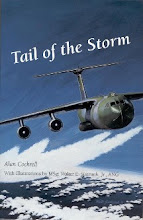I learned with some trepidation that our simulator
for my re-qualification ride was known as “Mildred.”
“Why the name Mildred” I asked my pilot
instructor (PI).
“Because she's a bitch.”
“But surely not all ladies with that name are
bitches,” said I.
“This one is,” he said.
The briefing then began. Two first officers
and I had gone non-current, all for different reasons. I had been grounded for
three months with a hurt arm. The others had more dubious excuses.
The PI said we each would fly a visual takeoff and landing, a V1 cut and an engine-out approach. I would be in the left seat the whole time. We sat through a quick review of all the maneuvers, made a head call and headed for the sim.
The PI said we each would fly a visual takeoff and landing, a V1 cut and an engine-out approach. I would be in the left seat the whole time. We sat through a quick review of all the maneuvers, made a head call and headed for the sim.
The route took us through a couple of
cavernous structures the size of hangars and alongside rows of simulators of
various types, most of which were in operation. "What's so bad about Mildred?" I had to yell at the PI to
make him hear me through the soup of sounds washing over us. Blowers bellowed,
relays clicked, hydraulic motors hummed and electrical gadgets buzzed and
whirred.
He explained that Mildred
was the oldest of our 767 simulators. She was cranky and mean. She didn’t like
to fly and sought every way possible to avoid it. Gremlins abounded in her
wiring, hydraulics and her Jurassic computers. And when she did fly, it was
nothing like a modern sim, much less a real plane. She was quirky, jerky, jumpy
and lurchy. He explained that the training center only used her when they had
to, due to outages of the other sims, or overflow training. “Sorry,” we’ve got
to use her, you guys,” he assured us. “Just do your best and we’ll get you on
your way.”
We reached the ladder, climbed high to the
tower of Mildred and entered her dark haunts. I took the left seat, Mark the
right and PI sat down at his panel and started throwing switches. He began
cursing immediately and was soon on the phone to sim maintenance soliciting a technician.
“Sorry guys, we’ve got to clear up some stuff here. Go ahead, strap in and get
ready to takeoff on runway 1C at Dulles, visual conditions.
I looked at my EHSI. We were on runway 12.
Mark said, “Look here!” I saw him pointing at the right engine instruments.
They were all blank. The PI leaned and looked. “Well, crap!” About then the
technician came up, grumbling. Obviously, Mildred was a pain in his neck too.
It looked as though the old gal had folded her arms, jutted out her lip and blocked
us from flying.
After a few minutes fiddling with it, the
technician shut Mildred down to darkness and rebooted her. We swapped war
stories while she came back to life and finally we were sufficiently ready to
go. A ton of stuff was wrong but we agreed none of it affected what we intended
to do. Mark took off and climbed into the night sky, which was reasonably well
represented in our windshields. We circled the airport and lined up on runway
1C. Mark’s approach was a little jerky. He couldn’t get used to Mildred’s weird
handling. I snickered when I heard him call her a pig. But he put her down
okay. Then the PI backed us up to the approach end, lowered the visibility to
1800 feet and said, “Now we’ll do a V1 cut. Questions?” We had none.
Mark pushed up the power and we rolled.
Dutifully I called the speeds as we reached them: “100 knots…V1…”
BOOM! Mildred shuttered.
The left engine instruments rolled back. We
swerved left. Mark kicked right rudder—too much. We headed for the right edge
lights. “ROTATE!” I yelled as we reached flying speed. Mark hauled back on the
yoke and we went airborne. He yelled out a curse. The wings rocked. We drifted
over the right side of the runway. We rolled right.
CRUNCH. (It actually was a crashing sound.)
Mildred stopped dead still. The sight picture in the windshield froze in a 60-degree
right bank. We were dead. Mark looked around. “Oops,” he said. “This bitch
really is hard to fly.”
The PI assured him not to worry, that the sim
was just too sensitive, and he admonished Mark to be especially delicate with
his control movements. We reset and flew another V1 cut, which was successful
but still jerky and unstable. By the third time Mark had developed a good
touch and Mildred seemed tamed.
Brent had sat in the jumpseat and watched
Mildred shred Mark. He bobbled and bucked for a few minutes before getting the feel. Then he too bolted for the airport shuttle.
Now
the PI slipped into the right seat to be my co-pilot. He positioned us on the
runway and I took off. I found Mildred as docile as a purring kitten. When we
turned onto a 10 mile night visual approach the PI began setting me up for an
ILS approach. “Wait!” I said. “I thought this was going to be a visual?”
“It is, but I thought I’d give you a descent
path for your flight director. Just to make
it a little easier, you know.” I looked
askance at him. Did he think I needed a crutch? What was I, a 25,000 hour
rookie? I could see the runway 10 miles ahead. Even saw the PAPI. I shook my
head. "No, I don’t want the ILS." He wouldn’t give up. “Well, let me program a
VNAV descent path for you.”
“No! I don’t want that either.” He looked
aghast at me when I reached up and slammed the flight director switch off. “Don’t
want no stinkin’ flight director either." I pointed at the runway. "I’ve got a PAPI. What
else do I need?” He shrugged and chuckled.
I set up a 700 fpm descent rate and kept two reds and two whites. The threshold came up and I planted Mildred where she likes it—on Terra Firma. When the V1 cut came, I knew Mildred didn’t like horsing with her rudder. I kept it gentle and smooth. She climbed on out on one engine, kept the centerline and accelerated.
Mildred's got a bum rap. Some parts of her didn’t work very well, but she
flew fine. A lot of people are like that.
The PAPI is on the left.
Are we high, low, or on glide path?
(I didn't take this. Got it off the Internet.)
On my way to Denver for simulator re-qual I
rode a 757 jumpseat and took this neat vid of
night arrival at the gate. The captain stops a
little too soon and has to spool back up to taxi
a few more feet. I hate it when I do that.
rode a 757 jumpseat and took this neat vid of
night arrival at the gate. The captain stops a
little too soon and has to spool back up to taxi
a few more feet. I hate it when I do that.






You are slightly low on the glide path.. Not too shabby! Enjoyed the story as usual.
ReplyDeleteRW from Oz
Slightly low. Either add a smidgen of power or pull up a tad if you have the speed reserve to do so. Of course, you know that already.
ReplyDeleteA little low. Should be 2 white and 2 red if you are on the glide slope. All red, your dead.
ReplyDeleteGreat post Captain, loved the action going on in the cockpit, hope you get back to the air soon and looking forward to your future posts.
ReplyDeleteA fun post and thanks, Alan. Mildred cannot be any worse than some of the REAL airplanes that you fly - with those endless lists of MEL'd items and I do refuse to believe that you were worried about the re-qual. Airplane drivers of your years and hours of experience simply do not forget 'how to do it' during a brief grounding. I'm very happy to know that you are flying again. I suspect that Mrs. Decision Height is even happier. Grounded pilots do not make good partners - and no, don't ask. Happy Landings, -C.
ReplyDeleteAs for the short-stop video... Stuff happens. Within the realm of possible taxiing 'errors,' this is a non-event. The only real 'harm' is to the captain's ego. I know (or hope) that most of you are concerned about far more important issues . -C.
ReplyDeleteMrs. DH is thrilled.
ReplyDeleteAny chance that you'll get to fly some 767-400's or 757-300's once the integration is complete?
ReplyDelete-Matt
Matt,
ReplyDeleteYes. It's already in the works.